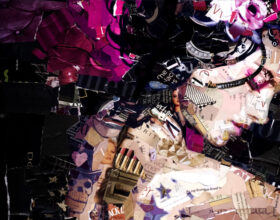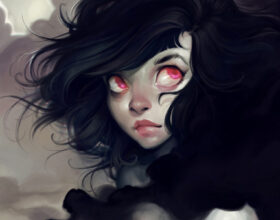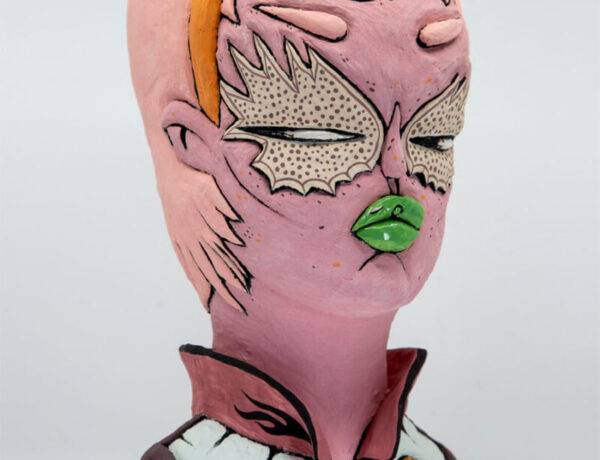In our digital age, we are surrounded with more and more faces than ever. Every social media you open will instantly project selfies and pictures of people, friends or strangers in front of your eyes. But, unfortunately, we are also living in an age where we avoid looking at other human beings in the streets we’re walking everyday. Empathy is what makes us human, beautiful. So we need to take time to stop and learn to look at others again. And Art is a good training, a good way to open our eyes, our ears and our hearts again to the many stories that are building humanity.
We recently wrote about the photorealistic paintings of Leigh Bongiorno. Their heartwarming power pushed us to talk with the American artist about the gorgeous crowd that lives under her brushwork.
What is your artistic background?
I have a background in Biomedical Art. I attended the Cleveland Institute of Art (CIA) for three years and cross registered at Case Western Reserve University. We had to take Anatomy and Physiology then some upper level medical courses. I also learned a lot of different computer software programs because I’d say more than 90% of Biomedical Art is digital. I did lots of 2D and 3D animations, flash programming, and illustrations in Photoshop and illustrator. We worked with University Hospitals of Cleveland, Cleveland Clinic, the Cleveland Natural History Museum, the Botanical Gardens and other research facilities. It was a lot of work. I think it made me more of a perfectionist than I already was. If our illustrations or animations weren’t accurate anatomically or physiologically then they were garbage basically. We were illustrating surgeries to teach physicians, so they had to be accurate. After that I freelanced for a short while for University Hospitals Gastroenterology department before moving and getting back to the fine arts.
I taught myself oil painting in high school, and then did a completely digital major, not a single painting at CIA. After graduating college, it had been about 8 years since I painted traditionally. I had to teach myself a greener way of painting when all the painting materials began giving me a headache. I researched artists I liked, watching their interviews and artist talks, studying pictures of them in their studios to see what was happening in the background. Through my research and trial and error I found a new greener way of painting that’s been working for me. I’m glad I found a way of painting that works because it was horrible having the thing I love make me so sick.
What are your influences/references/sources of inspiration?
Today I am influenced by the media, by the news, and by politics — it’s hard not to. But painting people of color, the homeless, and the LGBTQ is nothing new to me. The first oil painting I ever did was in high school, around 2005, of a homeless man in downtown Cleveland. I started painting pictures of my friends, which was a very diverse group. My best friend came out in college and her family wasn’t accepting of it and that influences me. The stories of my friends getting discriminated against for their color influences me. My homeless friends I made during my time in California influence me. Documentaries influence me. Music, movies, and other artworks influence me. Really everything that I come in contact with has some impact on me. But I know there’s a lot of bad in the world, a lot of things that could be improved and I want to use my skills to have a positive impact. I genuinely care about people.
What sparked your interest for realistic paintings, and especially portraiture?
I’ve always had an interest in drawing realistically; I never really knew anything different. My mom used to bake cakes on the side. She would use this color-flow icing technique and then paint these amazing pictures on the dried icing using food coloring. I was always watching her in the kitchen. When I got a little older, maybe around 5, she’d let me paint my own pictures with the food coloring and icing. I think growing up with her creativity was a major influence.
I never even saw a stick figure drawing until I started kindergarten. I thought it was really creative when I first saw a classmate’s drawing. I came home and told my mom about this great new way of drawing. She told me that they just couldn’t draw what they were seeing and to keep doing what I was doing. Throughout very early elementary school, I would draw all the Disney characters. I would draw the same character again and again until I got it right. By around 4th grade I think I made my first attempt at drawing realistically. I started drawing portraits then. My first attempt of realistic drawing was of Leonardo DiCaprio; I drew the Titanic with all the water pouring in – obviously Titanic was big at the time. Then I began going through the family photo albums and drawing some of the pictures in there. But I wasn’t doing a crazy amount of drawings back then; it was barely even a hobby. I still did typical kid stuff but drawing came very naturally to me. I didn’t really pursue it much until my later years of high school.
In high school I got a book on how to do realistic portrait drawing and redrew every picture in that book. Then I was going to do my first drawing on my own and decided to do a self-portrait. My art teacher back then mentioned juxtapositioning to me one day in class and those two things spawned my first series of surreal self-portraits. I fell in love after that.
How do you choose your models? Is their personality/story playing a role in the way you paint them?
A lot of times I recruit my friends for painting. If I have an idea in mind and think they’d be a great model, I’ll ask them if they’d let me take their photo for a painting. It’s kind of like casting for a movie where the director is looking for the right actor for the part. Other times I leave it up to fate. I would do a lot of street photography and just look for interesting people. I’d go up and introduce myself and ask them if I could take their photo for a painting. I’d talk to them, some more than others. I’d get to know them if I can. Sometimes we’d connect on social media. Other times if I’m just out and about and see someone I think could be a model I’ll ask them if they’d be interested in posing for a painting and we’ll set up a photo shoot at my studio or at a location.
Their personality definitely plays a role in how I paint them. When I painted my friend James, he was one of the nicest guys I ever met, like an angel, so put a halo behind him, draped his clothing, and tweaked the colors of his clothing to mimic religious iconography. I kept the string tucked into his shirt to keep it humble, because that’s who James was. I made him glow, his skin, and his aura. These were all conscious decisions.
The colors I choose can be changed to mimic a certain mood. I always try to look at my models’ photos and feel what they’re feeling at the time. If they’re smiling really big, I notice that I may have a little smile on my face when I’m painting them. And if they seem sad or concerned, I’ll mimic those expressions as well… but also, if I’m feeling certain way that may influence how I paint them. It’s like a dialogue going on between the painting and the painter.
What are the stories you’d like to share from the encounters you’ve made through your art?
The first one that came to my mind was of James. In my portrait “King James,” I painted a homeless friend of mine. He was larger than life in more ways than one. He was 6’6” with a size 13 triple E shoe. And his voice, it had so much soul. It was deep and warm and filled with so much love. His laugh was full and would fill you with life. He would always stand up and give his friends a hug that would make them forget all of their troubles. He was a true angel. But James had a few secrets. He was terminally ill. None of his friends, not even me, knew it. After finishing my painting of James, it was selected for the cover of a national art magazine. I gave James a copy and his face lit up. He said he felt like a celebrity.
A few weeks later he died. It’s interesting to me that I painted him in this religious way and that within weeks he passed. I think I was meant to paint James, the way I did, to tell his story. I met his family after he passed, they think he was depressed and went back to their hometown to feel closer to his mother who was already deceased. His sisters didn’t know what James living situation was. He’d always take the bus home for holidays. I think there’s a lot of people like James who are good, who have struggles who are just down and out. Many of us are just one paycheck away from the same situation.
Another time, I met a couple when I was doing street photography. I approached them because I loved their look with matching denim and blue hair. I wanted to take their picture. After talking to them I found out they were both transgender. We became friends on social media and later I found out one of them was diagnosed with cancer and was denied by his health insurance coverage because “men don’t have ovaries.”
I met a homeless Native American who lost his leg when it got stuck between two train cars. He came to Los Angeles to care for his mother who had recently passed and then he had nowhere to go.
Meeting these people has shown that we all have struggles, and a story, and you shouldn’t judge anyone. We’re all just here together trying to figure it out.
My latest paintings, while still figurative have been less about an individual’s story and rather about telling a larger story. What started out as a painting of my friend turned into a piece about gun violence in America. She is standing in this Tank Girl outfit holding a semiautomatic gun with teddy bears at her feet. The bears are dirty, torn, flopped over, and lying face down in the ground. They represent the youth whose lives were taken too soon. Then there are pins covering her jacket with symbols from all the deadliest mass shootings. She has a pin of the famous “Welcome to Fabulous Las Vegas Nevada” sign from the concert shooting in 2017. There’s a pin of the Batman symbol for the theatre shooting in 2012. Tally marks and sayings are scratched into the side of the gun, like the shooter had scratched into the side of his guns at the Navy Yard shooting in 2013. There’s a lot of symbolism in that piece.
What is your technique? Do you have favorite tools? A working ritual?
My technique is pretty traditional. I got to my technique through trial and error and by researching artists I like online. I usually take about 300 or so photos of my model/s and then I may compose them together in Photoshop until I get the composition I want. Then I draw out the piece to scale. It helps me work out all the details on paper which is much more forgiving that drawing on canvas. Once everything on the drawing is exactly what I want, I transfer the drawing to the canvas. I do a quick wash of color, the underpainting, and then I start building up the painting. I think I’ve always started painting the face first then work out from there.
As far as favorite tools, I use basic tools. I do most of my painting with really small detail brushes and this last year when pieces started getting really big, I started using a mahl stick to rest my hand on.
For my working ritual, I’m a night owl. I work from around 11am until 5am every day, unless I have an appointment or something. I put Netflix or music on in the background and turn on really bright lights in my studio so that no matter what time it is; the light is bright, which keeps me going.
Why do you think portrait painting are still relevant/important in the digital photography/social medias/selfies era?
Portrait painting is never going to be replaced by selfies and social media or photography. Selfies are not posted as art. They’re cheap, flat, and fleeting, with no meaning. They’re meant to be viewed and forgotten until the next one. An oil painting lives on for centuries. It becomes our culture which becomes part of our identity. It’s glimpse into what is happening at that point in time. It’s not necessarily the face that the artist captures but the story around what happened before and after that picture was made.
Gerhard Richter had a painting from a photograph of his aunt on display at the National Portrait Gallery. What made it interesting was that fact that after that photo was taken; she was placed in a mental institution and murdered by the Nazis. My portrait of James was similar; it’s the story around it that makes it really intriguing. It’s how I captured his essence. If I were to show you the photos that I used as reference for that painting, you would see the difference. I took someone that most of society looks past and placed him in a museum to capture everyone’s attention.
With portraiture, the way you paint can change the way it’s viewed. Your brushstrokes, the colors you choose, the way you balance an area of high contrast to low contrast, faded backgrounds, added symbolism that maybe wasn’t even initially there. You’re telling a story and strategically leading the viewer’s eyes around the piece. When done well, the viewer doesn’t know why their eye is drawn to one area, but I know why – I made it that way. I can make them feel however I want. Creating a painting is like writing a song or a book, or a film script. To say that the digital era of cheap selfies is replacing portraiture is outlandish.
Just as a film often fails to capture the greatness of a masterful piece of literature, a selfie and a photo can fail to capture the greatness of a portrait painting.
All the technology in the word can’t replace the creative mind.
Who are the people you’re going/willing to paint next?
I read the book “Far from the Tree” by Andrew Soloman. It was about having different identities and raising kids with different identities. Some of those identities include deafness, LGBTQ, dwarfism, autism, prodigies, schizophrenia and more. I illustrated the chapter on deafness for the city of Cleveland; but I really liked the whole book and would like to illustrate every chapter. Maybe I’ll reach out to the author and do a show with him and my art.
I’ve also been getting more into broader issues and illustrating a larger story more than one person’s story. I did the piece on gun violence (American Portrait), and plan to do more with that. Currently, I’m working on a piece about racism. I’d like to talk about women’s rights in the future as well. I’ve been trying to find a way to talk about what I want to talk about without opening too many personal wounds, but maybe that’s where my best work will come from.
What are your projects for the future (exhibitions, collaborations, travels, projects, etc)?
I’m currently working on a large piece about police violence and the corporation of the prison industrial complex. I was really inspired by the documentary “13th,” among others. I’m putting together lots of very complex pieces right now, conceptualizing them. I’ll be traveling to the Portrait Society of America’s annual conference for the first time to learn and meet new people. I’m debating on entering into some international portrait competitions. I have an editorial coming out this month in Whitehot Magazine, which should be really good. They asked some hard questions. I’m working on the design for my new art studio, with construction starting this summer. I’ve outgrown my current space. I’m also starting private figurative sculpture lessons this week. I’m super excited about that so you can expect some great figurative sculptures from me in the near future. I also just got asked to be a guest judge for the first time for an art competition, so it’ll be neat to see the other side of things.
Do you have a message you’d like to send with your art?
I hope that my art gets people to be more empathetic towards others. I’ve watched people stare at my painting of James and walk past him on the street. We need to slow down and pay attention to people. Maybe that person who snapped at you is just having a really bad day. Or the person who cut you off driving is rushing to the hospital. You don’t know what people’s lives are like. They could really be going through something and a small act of kindness could go a long way. You can either be the final blow to push someone over the edge or the one who pulls them back. I want to be that later.




